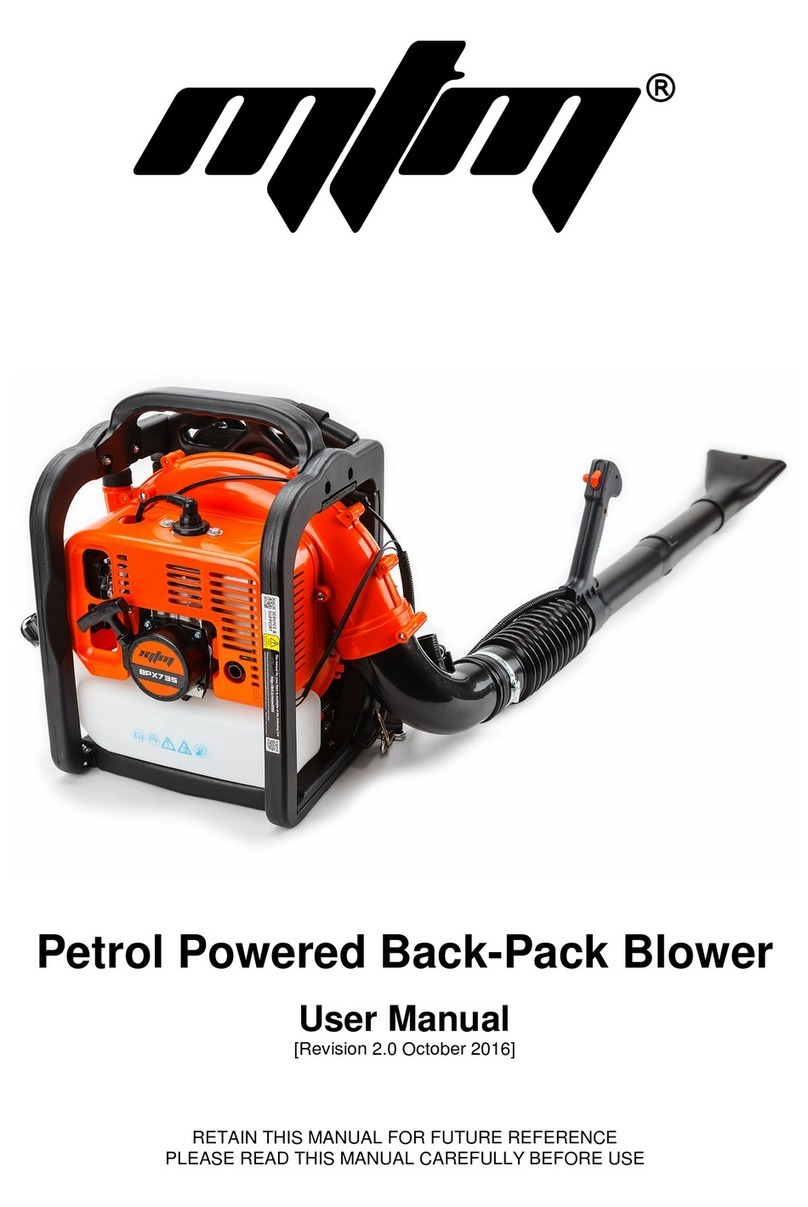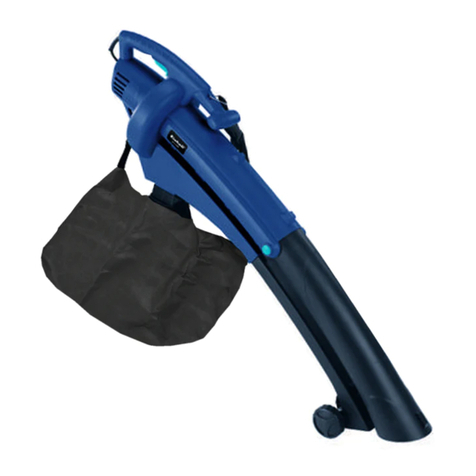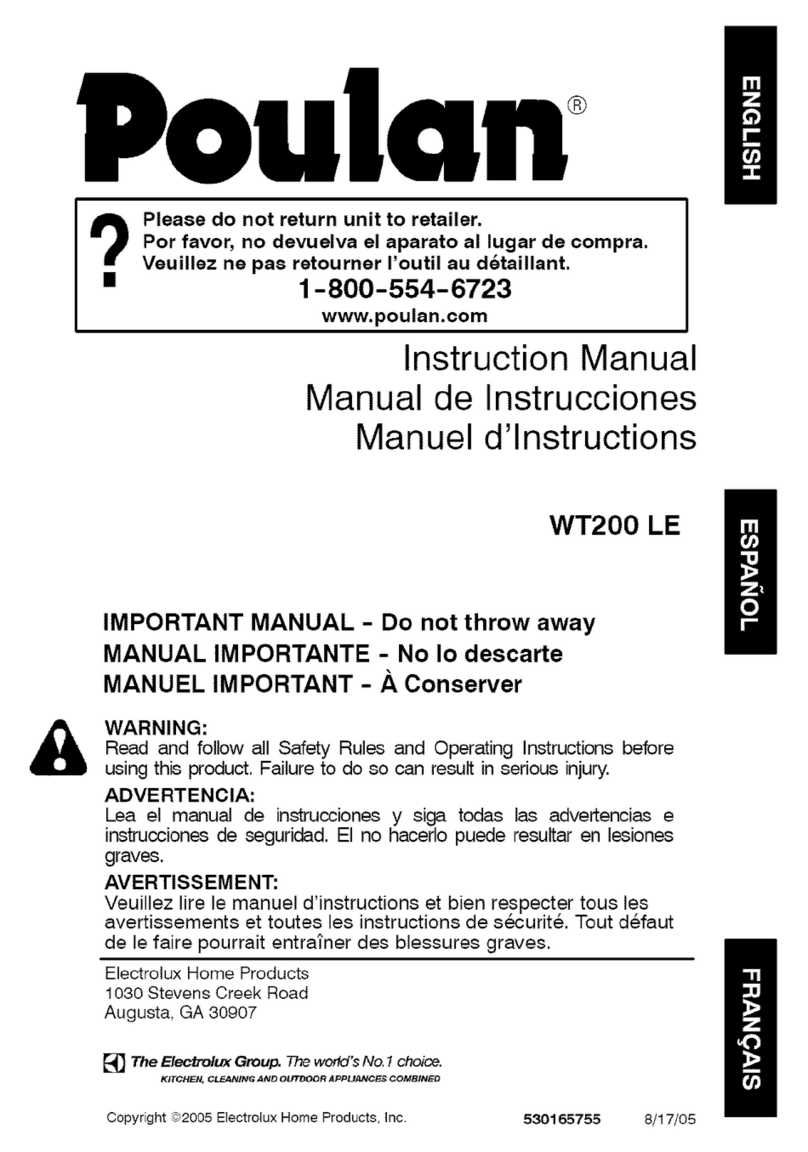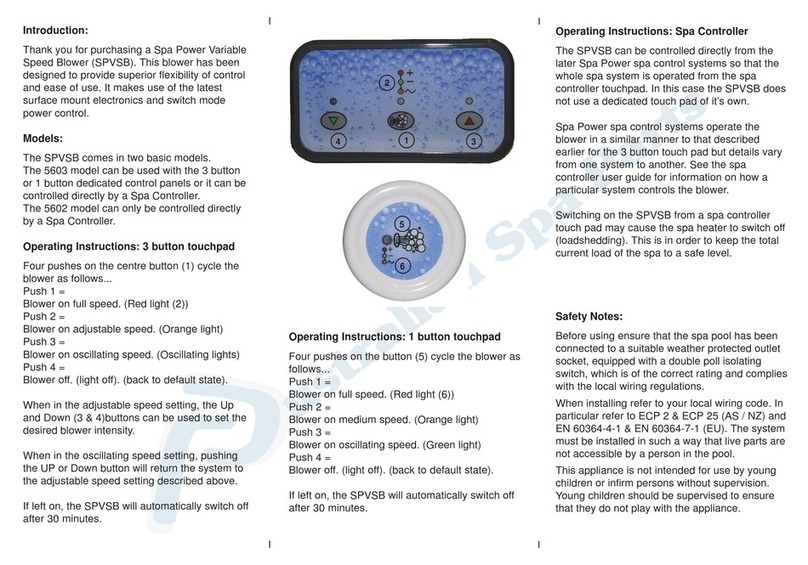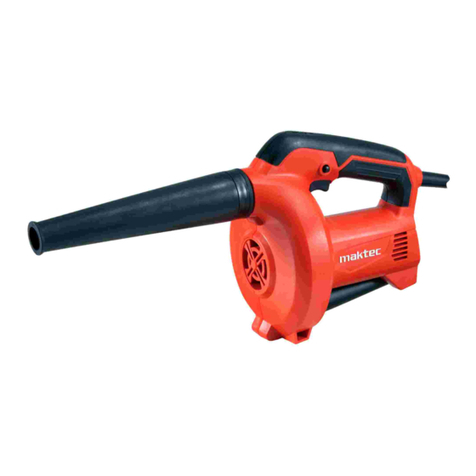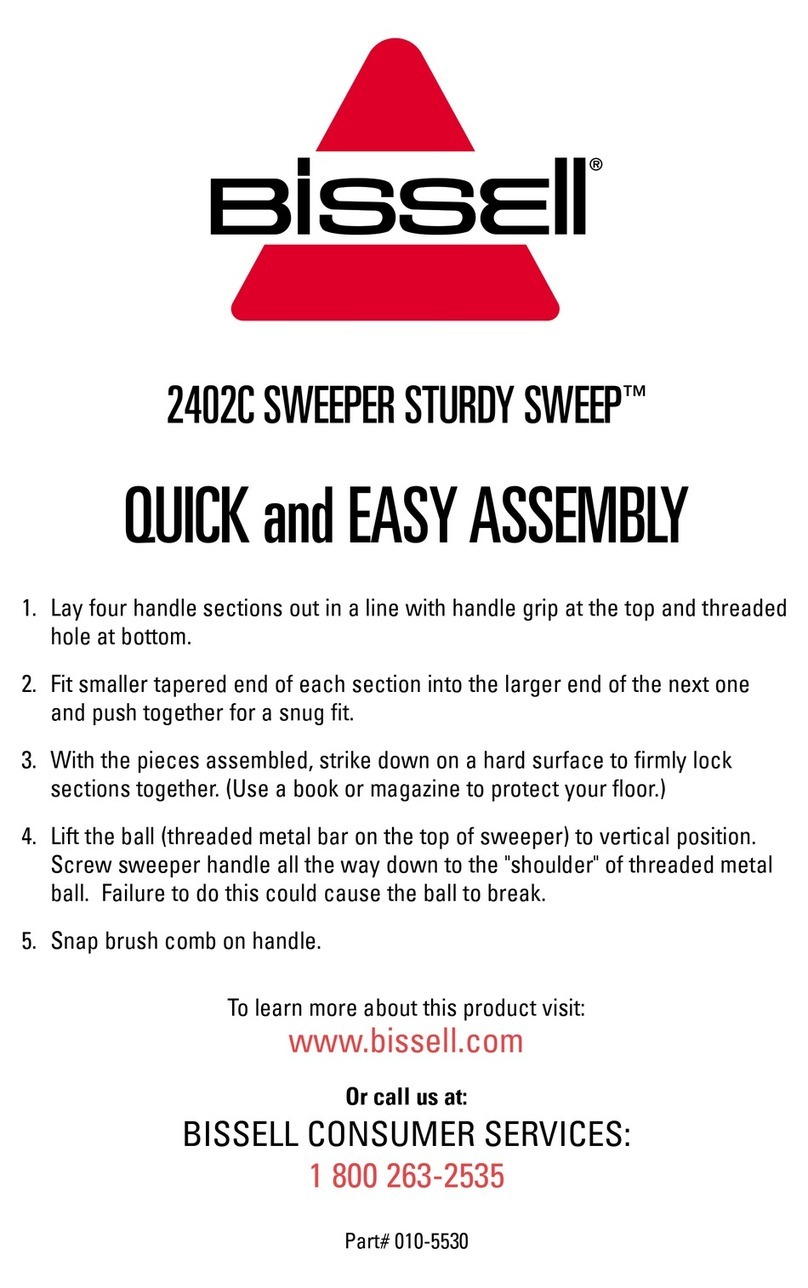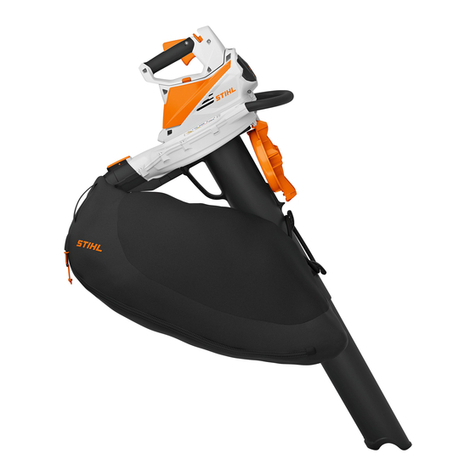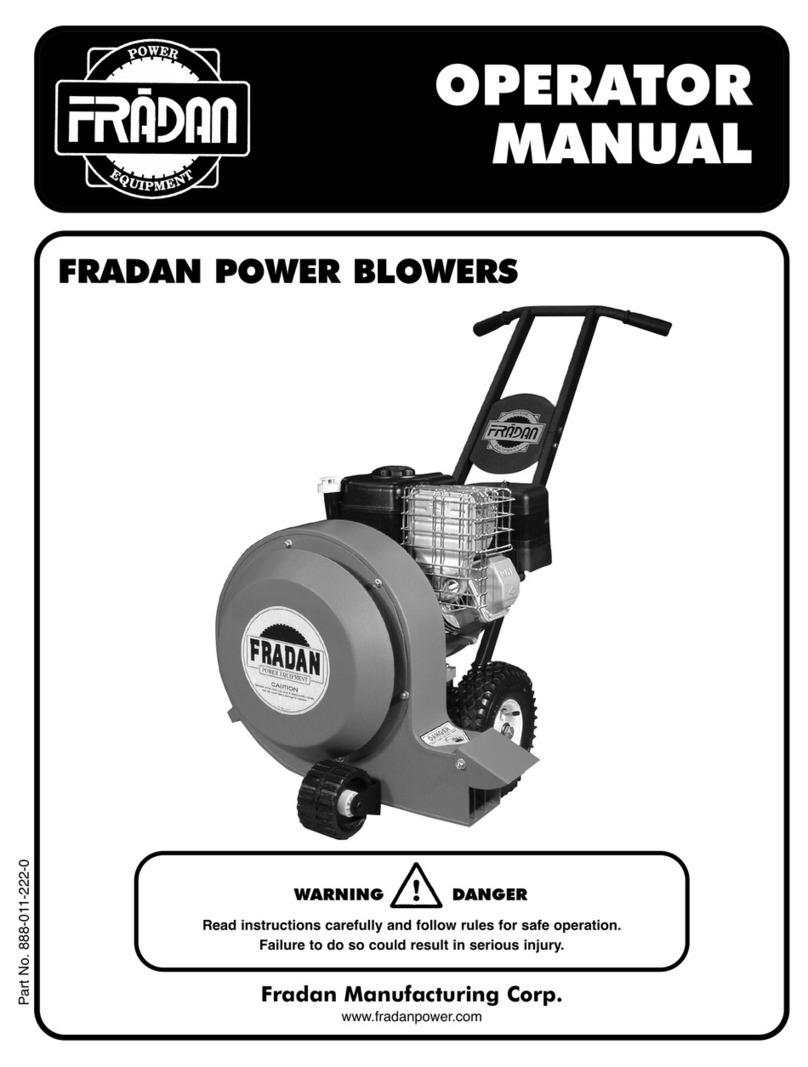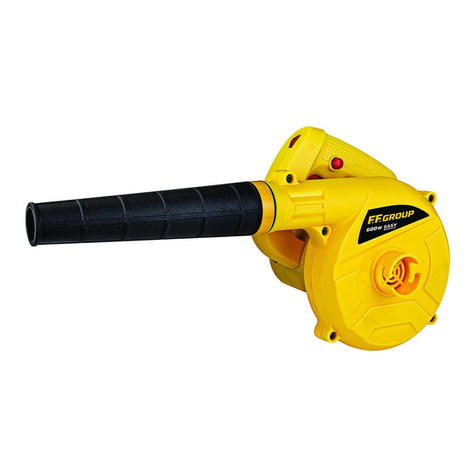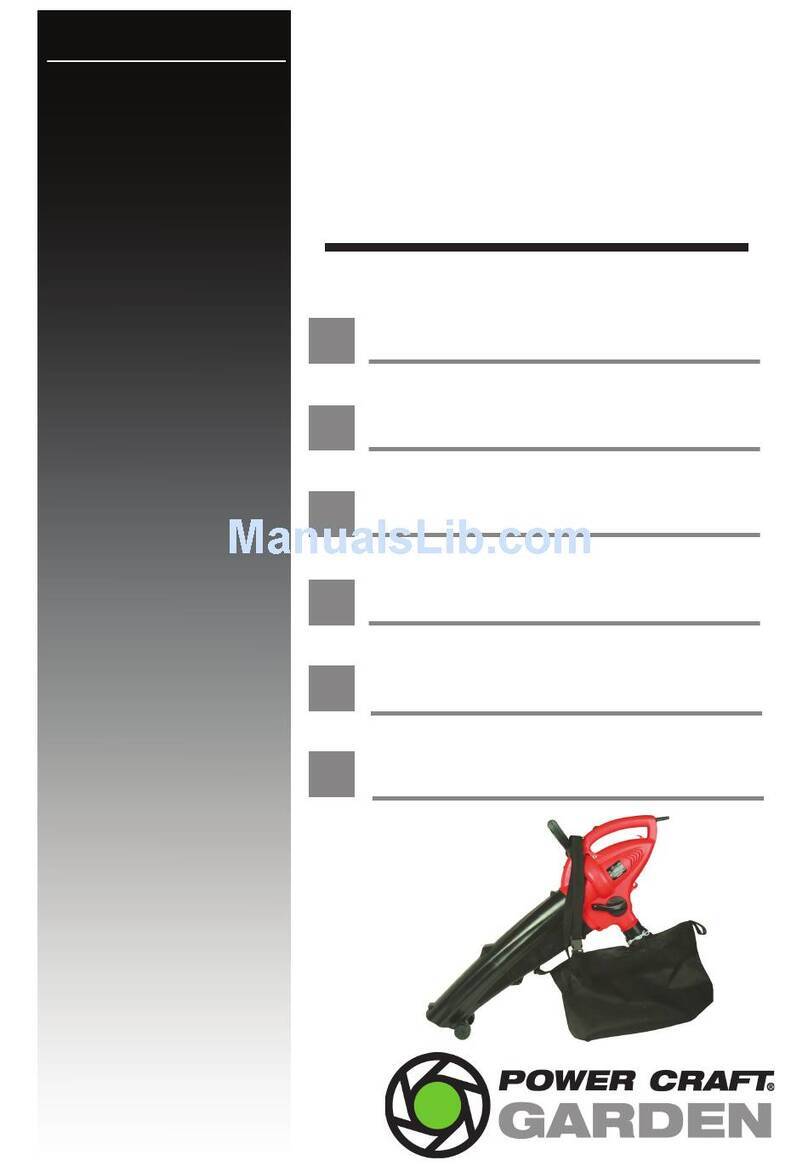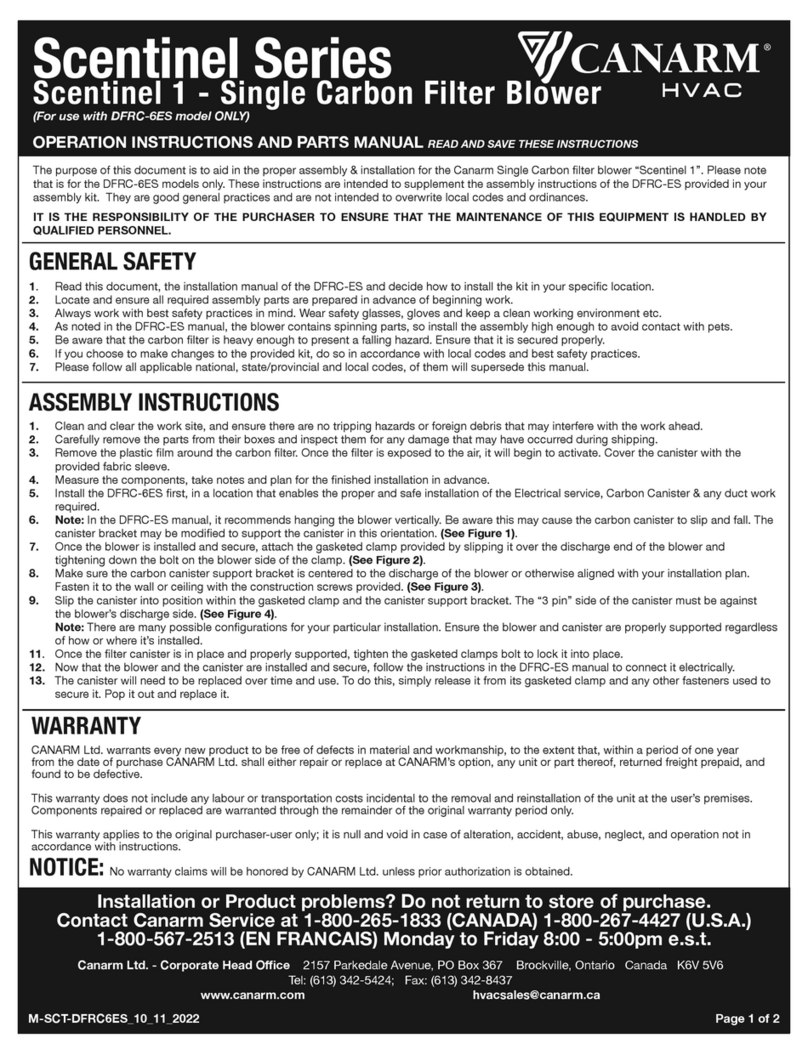MFM blwhndmtma6nk User manual

Petrol Powered Backpack Blower
User Manual
[Revision 5.0 March 2017]
READ THIS MANUAL CAREFULLY BEFORE USE – FAILURE TO DO SO MAY RESULT IN INJURY, PROPERTY
DAMAGE AND MAY VOID WARRANTY. • KEEP THIS MANUAL FOR FUTURE REFERENCE. • Products covered by
this manual may vary in appearance, assembly, inclusions, specifications, description and packaging.

Petrol Powered Backpack Blower
E&OE ©2017 MTM 2
Safety
Safety messages are designed to alert you to possible dangers or hazards that could cause death, injury or
equipment or property damage if not understood or followed. Safety messages have the following symbols:
You WILL be KILLED or
SERIOUSLY INJURED if you do
not follow instructions.
You CAN be KILLED or
SERIOUSLY INJURED if you do
not follow instructions.
You CAN be INJURED if you do
not follow instructions or
equipment damage may occur.
It is important that you read and
understand the instruction manual before
use and keep the manual in a safe place
for future reference. Safety information
presented here is generic in nature – some
advice may not be applicable to every
piece of equipment.
All safety precautions must be observed to
reduce the risk of personal injury when
operating the equipment.
The term “equipment" refers to your
product, be it electrical mains, battery or
petrol engine powered.
IMPORTANT – Handle the equipment
safely and carefully.
BEFORE USE - If you are not familiar with
the safe operation/handling of this
equipment, or are in any way unsure of any
aspect of suitability or correct use it for
your application, you should complete
training conducted by a person or
organization qualified in safe use and
operation of this equipment, including
fuel/electrical handling and safety.
WARNINGS
•Read all safety warnings and all
instructions. Failure to follow warnings
and instructions may result in electric
shock, fire and/or serious injury.
•Never run a petrol engine in confined
areas.
•Do not operate the equipment in
flammable or explosive environments,
such as in the presence of flammable
liquids, gases or dust. Engine and
equipment may create sparks or heat
that may ignite vapours, dust etc
•Keep clear of moving parts.
•This equipment may be a potential
source of electric shock if misused.
•Do not operate the equipment if it is
damaged, malfunctioning or is in an
excessively worn state.
•Do not allow others to use the
equipment unless they have read this
manual and are adequately trained.
•When using the equipment, basic
safety precautions detailed here must
always be followed to reduce the risk
of fire, electric shock, personal injury
and material damage.
•When wiring electrically powered
equipment, follow all electrical and
safety codes.
•Ensure all power sources conform to
equipment voltage requirements and
are disconnected before connecting
equipment.
General Work Area Safety
Work areas should be clean and well it.
Do not operate the equipment if
bystanders, animals etc are within
operating range of the equipment or the
general work area.
Personal Safety
Keep packaging away from children - risk
of suffocation! Operators must use the
equipment correctly. When using the
equipment, consider conditions and pay
due care to persons and property.
Prevent unintentional starting of the
equipment - ensure equipment and power
source switches are in the OFF position
before connecting or moving the
equipment. Do not carry equipment with
hands/fingers touching any controls.
Remove any tools or other items that are
not a part of the equipment from it before
starting or switching on.
Stay alert and use common sense when
operating equipment. Do not overreach.
Keep proper footing and balance at all
times. Do not use equipment when tired or
under the influence of drugs, alcohol or
medication. This equipment is not intended
for use by persons with reduced physical,
sensory or mental capabilities.
You must wear appropriate protective
equipment when operating, servicing, or
when in the operating area of the
equipment to help protect from serious
injury, including eye injury, inhalation of
toxic fumes, burns, and hearing loss.
Always wear eye protection. Protective
equipment such as respirators, non-skid
safety shoes, hard hat, hearing protection
etc should be used for appropriate
conditions. Other people nearby should
also wear appropriate personal protective
equipment. Do not wear loose clothing or
jewellery, which can be caught in moving
parts. Keep hair and clothing away from
the equipment.
If devices are provided for the connection
of dust extraction and collection facilities,
ensure these are connected and properly
used. Use of dust collection can reduce
dust-related hazards.
GeneralCare
Do not force the equipment. Use the
correct equipment for your application. The
correct equipment will perform better and
be safer within its design parameters. Do
not use the equipment if the ON/OFF
switch malfunctions – any equipment that
cannot be controlled with the ON/OFF
switch is dangerous and must be repaired.
Use the equipment and accessories etc. in
accordance with these instructions, taking
into account working conditions and the
work to be performed. Using the equipment
for operations different from those intended
could result in hazardous situations.
Before use, inspect the equipment for
misalignment or binding of moving parts,
loose components, damage or any other
condition that may affect its operation. If
damaged, have the equipment repaired by
an authorized service centre or technician
before use.
Always keep the equipment and
accessories (cutting tools, nozzles, bits
etc) properly maintained. Keep the
equipment, controls and handles dry and
free from dirt, oil and grease.
Store the equipment out of reach of
children or untrained persons. To avoid
burns or fire hazards, let the equipment
cool completely before transporting or
storing. Never place the equipment in
places where there are flammable
materials, combustible gases or
combustible liquids etc.
The equipment is not weatherproof, and
should not be stored in direct sunlight, at
high ambient temperatures or locations
that are damp or very humid.
Blower Use and Care
WARNINGS
•Always wear a face shield when
operating the machine.
•Maintain a distance of at least 20m
(60') between the operator and any
bystanders, animals etc.
•Never blow debris in the direction of
bystanders.

Petrol Powered Backpack Blower
E&OE ©2017 MTM 3
General Fuel Safety
Petrol/fuel/gasoline is extremely
flammable – keep clear of
naked flames or other ignition
sources.
•Do not spill fuel. If you spill fuel, wipe
it from equipment immediately – if fuel
gets on your clothing, change them
immediately
•Do not smoke near fuel.
•Always shut off the engine before
refuelling.
•Do not refuel a hot engine.
•Open the fuel cap carefully to allow
any pressure build-up in the tank to
release slowly.
•Always refuel inwell ventilated areas.
•Always check for fuel leakage. If fuel
leakage is found, do not start or run
the engine until all leaks are fixed.
General Service Information
•Have the equipment serviced or
repaired at authorized service centres
by qualified personnel only.
•Replacement parts must be original
equipment manufacturer (OEM) to
help ensure that equipment safety is
maintained.
•Do not attempt any maintenance or
repair work not described in this
instruction manual.
•After use, the equipment and
components may still be hot – allow
the equipment to cool and disconnect
spark plugs and/or electrical power
sources and/or batteries from it before
making adjustments, changing
accessories or performing repair or
maintenance.
•Do not make adjustments while the
equipment is running.
•Perform all service related activities
under suitable conditions, such as a
workshop etc.
•Replace any worn, damaged or
missing warning labels immediately.
•Do not clean equipment with solvents,
flammable liquids or harsh abrasives.
DANGER
Running combustion engines in confined areas
CAN KILL IN MINUTES. Engine exhaust fumes
contain carbon-monoxide – a deadly gas that
you cannot smell or see.
NEVER run a combustion engine in confined
areas EVEN IF windows and doors are open.
ONLY run petrol engines OUTDOORS and away
from doors, windows and vents.
Do not operate the equipment in hazardous locations, such as
where there may be a risk of fire or explosions from flammable
liquids, gases or dust.
Do not operate the equipment in confined areas where exhaust
gases, smoke or fumes could reach dangerous concentrations.
Do not refuel a combustion engine while it is running, on or hot.
Never smoke while refuelling combustion engines or handling
flammable substances.
For generators, the electrical output is potentially lethal and must
only be connected to a fixed electrical installation by an
appropriately licensed person.
Be aware that the equipment may include hazardous
components, such as blades, hot surfaces and moving parts.
Handle any flammable substance with extreme caution.

Petrol Powered Backpack Blower
E&OE ©2017 MTM 4
Table of Contents
Safety...................................................................................................................................................2
Included Items....................................................................................................................................5
BLWHNDMTMA6NK..................................................................................................................................5
BLWHNDMTMA6WK.................................................................................................................................5
Assembly ............................................................................................................................................6
Adjusting the Backpack Harness and Control Handle.........................................................................7
Fuel and Lubrication..........................................................................................................................7
Operation ............................................................................................................................................8
Starting the Engine.....................................................................................................................................8
Stopping the Engine...................................................................................................................................8
Operating the Blower .................................................................................................................................9
Maintenance .....................................................................................................................................10
Checking, Cleaning or Replacing the Air Filter.........................................................................................10
Air Filter Inspection and Cleaning......................................................................................................10
Air Filter Removal/Installation............................................................................................................10
Cleaning the Fuel Filter............................................................................................................................10
Spark Plug ...............................................................................................................................................11
Spark Plug Cleaning and Gap Checking...........................................................................................11
Spark Plug Removal/Installation........................................................................................................11
Storage..............................................................................................................................................12
Removing from Storage...........................................................................................................................12
Troubleshooting...............................................................................................................................13
Specifications...................................................................................................................................14

Petrol Powered Backpack Blower
E&OE ©2017 MTM 5
Included Items
BLWHNDMTMA6NK
1x Extension Tube
1x Standard Nozzle
1x Narrow Nozzle
BLWHNDMTMA6WK
6x Extension Tubes
1x Curved Nozzle
1x Standard Nozzle
1x Narrow Nozzle

Petrol Powered Backpack Blower
E&OE ©2017 MTM 6
Assembly
Note: Place the hose clamps over the flexible tube before connecting it. • Place the unit on a flat surface
during assembly.
1. Slide the flexible tube (B) over the fan outlet tube (A) and secure it using a hose clamp (C). Firmly
tighten the clamp.
Note: Keep the throttle cable as straight as possible when connecting the blower tubes. • Ensure the hose
clamp screw is positioned away from the operator.
2. Slide the flexible tube (B) over the control tube (E).
3. Rotate the control tube so that the alignment mark (D) and throttle handle (F) are aligned, then secure
the tubes using a hose clamp (G). Firmly tighten the clamp.
4. Attach the throttle linkage clips to both ends of the flexible tube to secure the throttle cable.
5. Connect the intermediate tube (H) and air nozzle (I) by pushing them together and turning them
clockwise so that they lock.

Petrol Powered Backpack Blower
E&OE ©2017 MTM 7
Adjusting the Backpack Harness and Control Handle
1. Place the blower on your back by slipping arms through the shoulder straps as if you were putting on a
jacket.
2. Once adjustments have been made to the straps for user comfort, remove the blower from your back
and place on a level ground in an upright position.
3. Adjust the backpack harness and control handle position as required so that the unit is comfortable and
easy to control.
Fuel and Lubrication
Petrol/fuel/gasoline is extremely flammable – keep clear of naked flames or other
ignition sources. • The engine must be cool before refuelling. • Do not run the engine
on un-mixed fuel or fuel that is not mixed at the correct ratio. Failure to use the correct fuel type / mixture
may permanently damage the engine and void product warranty. • Mix the fuel thoroughly before adding
to the unit. • Some conventional petrol blends use oxygenates such as alcohol or other compounds to meet
emission requirements. This engine is designed to operate satisfactorily on any petrol for automotive use
including these types of blends.
Adequately fill the fuel tank with the correct fuel type.
•Use non-ethanol unleaded mixed at a 40:1 ratio with 2-stroke engine oil (higher RON values and good
quality 2-stroke oil will provide best engine performance). Do not use old or contaminated fuel/oil. Fuel/oil
mix ratio examples are shown below.
Petrol (Litre) 1 2 5 10
Oil (Millilitre) 25 50 125 250
Engine Idle Adjustment
In some cases due to operating conditions (altitude, temperature
etc.) the engine may not idle reliably after fully warming up. If this
occurs, a slight adjustment to the idle speed may be required.
1. Locate the carburettor idle adjustment screw (G).
2. Use a Phillips or slotted-screwdriver to rotate the idle
adjustment screw right (clockwise) 1/4 turn.
3. Check the idle. If the engine still does not idle reliably, repeat
step 2. If the engine still not idle or further adjustments are
necessary, take the machine to an authorised service centre.

Petrol Powered Backpack Blower
E&OE ©2017 MTM 8
Operation
Starting the Engine
Always pull the starter cord straight out. Pulling it at an angle will cause it to rub against the
machine, which may damage it and wear it more quickly. • Allow the starter cord to retract slowly –
do not let it "snap" back. This could cause the rope to snag or fray and also damage the starter assembly.
1. Place the engine ON / OFF switch (A) in the "ON" ("I") position.
2. If the unit is new, has just been re-fuelled or has not been used for a period of time, press the fuel primer
bulb (B) repeatedly until it feels firm.
3. Place the choke (C) in the most suitable position, depending on engine temperature and ambient
temperature. For cold engines, use "COLD" and for hot engines, use "RUN".
4. With the unit on the ground, hold the top handle and step on the bottom frame to steady it. To start the
engine, slowly pull the starter cord until you feel it engage the engine, then pull rapidly. Repeat until the
engine starts. If the engine does not start after more than 4 attempts, reduce the amount of choke and
attempt to start the engine.
5. Once the engine has started, allow it to warm up, gradually reducing choke until it is in the "RUN"
position before using the machine.
If the engine fails to start after repeated attempts, refer to Troubleshooting.
Stopping the Engine
Emergency Stopping Procedure
Place the engine ON / OFF switch in the "OFF" position.
Normal Stopping Method
For normal stopping, release the trigger and allow the engine to return to idling speed. Then place the engine
ON / OFF switch in the "OFF" position.
A
B
C
Video Tutorial:
Starting 2-Stroke Engines

Petrol Powered Backpack Blower
E&OE ©2017 MTM 9
Operating the Blower
Always wear a face shield when operating the machine. • Maintain a distance of at least 20m (60')
between the operator and any bystanders, animals etc. • Never blow debris in the direction of
bystanders.
With the engine running, press and hold the lock-out button (A) button, then squeeze the throttle (B) to
activate the blower and adjust engine speed.
The velocity of the air stream is dependent on engine speed – use the throttle to adjust engine speed / air
velocity as required when using the machine.
•Stand at a distance away from debris that will easily allow you to control its direction as it is blown.
•Use rakes and brooms to loosen debris before blowing. In dusty conditions, slightly dampen surfaces.
A
B

Petrol Powered Backpack Blower
E&OE ©2017 MTM 10
Maintenance
Checking, Cleaning or Replacing the Air Filter
Operating the machine without a functional air filter may cause severe engine damage and will void
any warranty. • A dirty or oil saturated air filter will restrict air flow, which can be mistaken as fuel
system problems. Check the condition of the air filter before adjusting engine idle speed, where applicable. •
If the air filter is damaged (torn, broken, disintegrating), replace it.
The air filter is used to prevent dirt and other particles from possibly entering the engine and causing internal
damage to it. The air filter requires regular maintenance as per the maintenance schedule.
Air Filter Inspection and Cleaning
Inspect the air filter for dirtiness and debris, damage etc. Clean or replace the filter element as necessary. To
clean air filters:
•For foam filters, wash the filter in warm water and mild detergent, then rinse and allow to dry.
•Clean all other air filter assembly components using water and mild detergent, then dry them.
•For foam filters, place a few drops of clean engine oil on the filter then squeeze it a few times to spread
the oil through the filter material and remove any excess oil.
Air Filter Removal/Installation
1. Loosen the knob (A) holding the air filter cover in place.
2. Remove the air filter cover (B) and lift the filter (C) from the air intake assembly.
Cleaning the Fuel Filter
Remove fuel from the tank and store it in an approved container before starting this procedure.
1. Open the fuel cap to slowly release any pressure in the fuel tank, then remove the cap.
2. Use a piece of wire to hook the fuel tube/filter (C), then pull the filter from the tank.
3. Remove the fuel filter from the tube with a twisting motion.
4. Ensure that the fuel tank vent (A) is clean. Clean the fuel filter of obstructions etc using petrol or solvent.
Never operate the blower without the fuel filter. Internal damage could result.

Petrol Powered Backpack Blower
E&OE ©2017 MTM 11
Spark Plug
If the spark plug is damaged (cracked insulator, broken or eroded electrodes etc), replace it. •
Always use spark plugs of the same type as originally supplied.
The spark plug is used to ignite the air/fuel mixture inside the engine. The spark plug has electrodes on one
end and an electrical terminal on the other. The spark plug requires regular maintenance.
Spark Plug Cleaning and Gap Checking
The spark plug should be checked and cleaned approximately every 6 months.
1. Remove any carbon deposits on the spark plug (A) electrodes (B) with a wire
brush.
2. Clean the spark plug threads and the electrical terminal (C) on the top.
To check and adjust the spark plug “gap”:
1. Use “feeler” or “thickness” gauges (X) to measure the existing gap. The gauge
must drag a little when being slid between the electrodes (2) – this means the
measurement is fairly accurate.
2. Adjust the gap to 0.6mm (0.025"). If the gap needs to be reduced, gently tap the
electrode as required. If the gap needs to be increased, use pliers to gently pull
the electrode as required.
3. Measure the gap again and ensure it is within the specified range before re-installing the spark plug.
Spark Plug Removal/Installation
1. Pull the electrical lead from the terminal on top of the spark plug.
2. Clean the area around the spark plug so that no dirt or other material can enter the engine when the
spark plug is removed.
3. Use the spark plug tool to remove the spark plug (rotate left).
To re-install the spark plug:
1. Place the spark plug in its hole and screw it in (rotate right) until “finger tight”.
2. Use the spark plug tool to tighten the spark plug approximately one quarter turn (do not over-tighten).
3. Place the electrical lead over the spark plug terminal and push it down so that it connects firmly with the
terminal
A
B
B
X
A

Petrol Powered Backpack Blower
E&OE ©2017 MTM 12
Storage
Failure to follow these steps may cause varnish to form in the carburettor. If this happens then the
carburettor will have difficulty starting.
1. Perform all the general maintenance recommended in the maintenance section of your user manual.
2. Clean the outside surface of the blower.
3. Drain fuel from the fuel tank.
4. After the fuel is drained, start the engine.
5. Run at engine at idle until it stops. This purges the carburettor of fuel.
6. Allow the engine to cool.
7. Remove the spark plug.
8. Pour one teaspoon of clean 2-stroke oil into the combustion chamber. Pull the starter cord slowly several
times to coat internal components. Re-install the spark plug.
9. Store the machine in a cool, dry place away from sources of ignition (oil burner, water heater etc).
Removing from Storage
1. Remove the spark plug.
2. Pull the starter cord briskly several time to clear excess oil from the combustion chamber.
3. Re-install the spark plug.

Petrol Powered Backpack Blower
E&OE ©2017 MTM 13
Troubleshooting
Problem Probable Cause Corrective Action
Engine does not start, or
starts but will not run Incorrect starting procedures Follow instructions in the user manual
Incorrect carburettor mixture Have carburettor adjusted by an authorised
service centre
Fouled spark plug Clean/gap or replace plug
Empty fuel tank Fill fuel tank with properly mixed fuel
Primer bulb was not pressed
enough Press primer bulb fully and slowly ten times
Engine starts, but has low
power Fuel filter is plugged Replace spark arrestor screen
Incorrect lever position Move to run position
Dirty spark arrestor screen Replace spark arrestor screen
Dirty air filter Remove, clean and reinstall filter
Engine hesitates Incorrect carburettor mixture setting Have carburettor adjusted by an authorised
service centre
Air filter is plugged Replace or clean the air filter
Old or improperly mixed fuel Drain gas tank/add fresh fuel mixture
Air filter is plugged Replace or clean the air filter
Fouled spark plug Replace or clean the spark plug
Incorrectly gapped spark plug Clean/gag or replace plug
Dirty air filter Clean or replace air filter
Smokes excessively Incorrect carburettor mixture setting Have carburettor adjusted by an authorised
service centre

Petrol Powered Backpack Blower
E&OE ©2017 MTM 14
Specifications
Engine Type Single cylinder 2-stroke
Displacement 30cc
Idle Speed 3500RPM
Maximum Engine Speed 9000RPM
Ignition Type CDI
Maximum Air Velocity Approximately 450 km/h
Air Volume Approximately 13m3/min
Fuel Type Non-ethanol unleaded
Fuel Capacity 500ml
Fuel Ration 40:1 (40 parts fuel to 1 part 2- stroke oil)

Petrol Powered Backpack Blower
E&OE ©2017 MTM 15
Some experts believe that the incorrect or prolonged use of almost any
product may cause serious injury or death. To help reduce your risk of serious
injury or death, refer to the information below. For more information, see
www.datastreamserver.com/safety
Consult all documentation, packaging and
product labelling before use. Note that
some products feature documentation
available online. It is recommended to print
and retain the documentation.
Before each use, check the product for
loose/broken/damaged/missing parts, wear
or leaks (if applicable). Never use a
product with
loose/broken/damaged/missing parts, wear
or leaks.
Products must be inspected and serviced
(if applicable) by a qualified technician
every 6 months. This is based on average
residential use by persons of average size
and strength, and on a property of average
metropolitan size. Use beyond these
recommendations may require more
frequent inspections/servicing.
Ensure that all users of the product have
completed a suitable industry recognised
training course before being allowed
access to the product.
The product has been supplied by a general merchandise
retailer that may not be familiar with your specific
application or description of application. Be sure to attain
third-party approval from a qualified specialist for your
application before use, regardless of any assurances from
the retailer or its representatives.
This product is not intended for use where fail-safe
operation is required. As with any product (for example,
automobile, computer, toaster), there is the possibility of
technical issues that may require the repair or replacement
of parts, or the product itself. If the possibility of such failure
and the associated time it may take to rectify could in any
way inconvenience the user, business or employee, or
financially affect the user, business or employee, then the
product is not suitable for your requirements. This product is
not intended for use where incorrect operation or a failure of
any kind, including but not limited to, a condition requiring
product return, replacement, parts replacement or service
by a technician may cause financial loss, loss of employee
time or an inconvenience requiring compensation.
If this product has been purchased in error when
considering the information presented here, contact the
retailer directly for details of their returns policy, if required.
©2017 MTM. All rights reserved. No part of this document, including descriptive content, concepts, ideas,
diagrams or images may be reproduced or transmitted in any form or by any means, electronic or
mechanical, including photocopying, scanning or recording, or any information storage and retrieval system,
without express permission or consent from the publisher.
Table of contents
Other MFM Blower manuals
